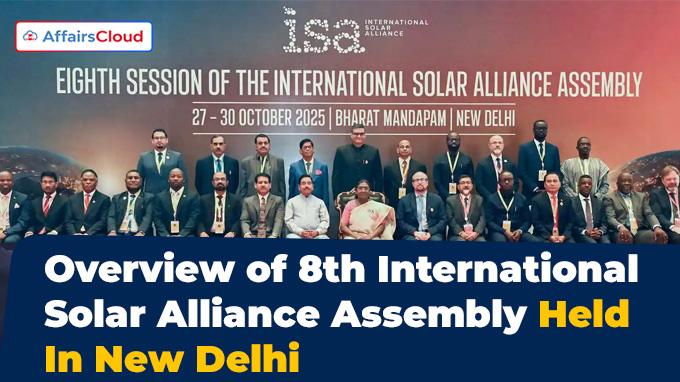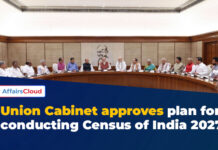The Government of India(GoI), in partnership with the International Solar Alliance (ISA), hosted the 8th Session of the ISA Assembly from October 27 to 30, 2025 at Bharat Mandapam in New Delhi, Delhi.
- The assembly was chaired by Union Minister Pralhad Joshi, Ministry of New and Renewable Energy(MNRE) and co-chaired by Benoit Faraco, the special envoy for Climate Negotiations, France.
- The opening plenary of the 8th ISA Assembly was inaugurated by the President of India, Droupadi Murmu, who called for inclusive and sustainable growth.
Exam Hints:
- What? 8th Session of ISA Assembly
- When? October 27–30, 2025
- Where? Bharat Mandapam, New Delhi
- Organized by: GoI & ISA
- Theme: “One Sun, One World, One Grid”
- Chair: Union Minister, Pralhad Joshi,(MNRE)
- Co-chair: Benoit Faraco (France)
- Inaugurated by: President Droupadi Murmu
- Entry: China to join ISA
- Initiatives launched: SUNRISE, OSOWOG, GCC & ISA Academy, SIDS Solar Procurement Platform, ASF
- ISA Reports: EODS 2025; Solar PV Skills & Jobs in Africa; Global Solar Trends & Outlook 2025; Solar Compass-Special Issue on Integrated PV Applications; Global Floating Solar Framework
- Site Visits: Kilokri BESS; Digital Twin Project.
About ISA Assembly:
Overview: ISA Assembly is the highest decision-making body of the ISA, which meets annually to review progress, decides on strategic plans, programs, and policies, and approves budgets, projects, and partnerships.
Previous Session: The 7th session of the ISA Assembly held from November 3 to 6, 2024, in New Delhi.
Highlights of 8th ISA Assembly:
Theme: The 2025 assembly was held under the theme titled “One Sun, One World, One Grid”.
Focus: The assembly focused on mobilizing solar finance, building global solar capacity, promoting solar manufacturing, and supporting Small Island Developing States (SIDS) and Least Developed Countries (LDC).
Participants: The event witnessed participation of delegates from more than 124 countries and 40 ministers.
China Joins ISA: Ashish Khanna, Director-General (DG) of the ISA, announced that China will join ISA to expand its global reach.
- China contributes nearly 80–90% of global solar manufacturing, and its inclusion marks a key step in strengthening the global solar ecosystem.
India’s Solar Achievements : Union Minister Pralhad Joshi, Ministry of New and Renewable Energy(MNRE) hailed the strong global presence at the ISA Assembly, noting that ISA nations contribute about 40% of global solar capacity.
- He added that 21 lakh installations under the PM Surya Ghar: Muft Bijli Yojana(PMSG: MBY) have been completed, with 48% of beneficiaries achieving zero electricity bills.
Global solar initiatives:
On October 28, 2025, during the 8th ISA Assembly, the GoI launched several flagship initiatives aimed at accelerating the global shift toward affordable, inclusive, and circular solar energy.
Solar Upcycling Network for Recycling, Innovation & Stakeholder Engagement (SUNRISE) initiative:
Aim: To build a global, collaborative platform dedicated to managing the entire lifecycle of solar technologies from installation to decommissioning, focusing on recycling, innovation, and sustainability.
Objectives: To recover and reuse critical minerals such as lithium, cobalt, nickel, silver, and silicon, from end-of-life solar panels and batteries, reduce solar electronic (e) waste, and promote a circular economy within the Renewable Energy (RE) ecosystem.
Support: The initiative led by the ISA, with support from the National Institute of Solar Energy (NISE), Ministry of New and Renewable Energy (MNRE), United Nations Environment Programme (UNEP), and various industry stakeholders.
Member countries: ISA member countries across Asia, Africa, and Latin America will participate in the initiative, with implementation set to begin in 2026, beginning with pilot recycling hubs in India, Kenya, and France.
Features: It includes establishing recycling hubs and Research and Development (R&D) centres for solar waste, encouraging circular economy practices in the solar value chain, and promoting technology sharing and innovation in solar panel upcycling.
- It also includes addressing the growing challenge of solar e-waste as global solar installations have increased and involving Public-Private Partnerships (PPP) for material recovery and sustainable disposal.
One Sun, One World, One Grid (OSOWOG) Initiative:
Overview: It was launched by GoI and the United Kingdom (UK), envisions a globally interconnected solar power grid, enabling the transfer of clean energy across borders, from regions with surplus solar power to those with deficits.
Partner agencies: It will be led by the ISA in collaboration with partner agencies such as the World Bank(WB), the Green Grids Initiative (GGI) of UK, and other international organizations.
- Over 120 ISA member countries will participate, with India serving as the nodal hub, utilizing its geographic advantage and RE capacity to enable intercontinental energy flow.
Objective: Its objective is to establish a transnational electricity grid that links solar energy generation and transmission networks across countries, ensuring full time availability of green power, reduced dependence on fossil fuels, and optimized utilization of renewable sources globally.
Phased Implementation: It begins with Phase 1, focusing on the interconnection of grids within the Asia-Middle East-Africa region.
- Phase 2 will expand the network to include Europe and the Pacific region, strengthening transcontinental energy links.
- Phase 3 will establish a fully integrated global green grid, ensuring the continuous and seamless flow of RE worldwide.
Focus: The initiative focuses on technological and financial support for grid modernization, energy storage systems, and cross-border power trading frameworks, backed by multilateral agencies and PPP.
Global Capability Centre(GCC):
Overview: The GCC represents a major milestone towards creating a “Silicon Valley for Solar” in India. It will serve as a central innovation and knowledge hub to strengthen global collaboration in solar technology, research, and entrepreneurship.
Model: GCC will operate through a hub-and-spoke model, with India as the central hub connected to Solar Technology Application Resource – Centres (STAR-C), national Centres of Excellence (CoEs) established across ISA member countries.
- STAR-Cs will act as regional spokes, promoting solar innovation, skill development, training, and Technology Transfer.
ISA Academy:
Platform: It is an Artificial Intelligence (AI)-driven online learning platform designed to democratize access to solar knowledge, launched with an aim to complement GCC.
Features: It offers personalized, adaptive learning pathways for students, professionals, policymakers, and entrepreneurs.
SIDS Solar Procurement Platform:
Overview:The Small Island Developing States (SIDS) Solar Procurement Platform was launched under the ISA to help SIDS access clean, affordable, and reliable energy.
Aim: The platform, jointly developed by the ISA,WB Group, and India as the host and primary supporter, aims to ensure that vulnerable island nations which face high energy costs, limited land availability, and severe climate risks, gain affordable, reliable, and sustainable access to solar energy.
MoU: The launch included the signing of an in-principle Memorandum of Understanding (MoU) by ministers and heads of delegations from SIDS nations.
- Under the MoU, India will provide technical expertise in solar design, training, procurement models, financial support through the facilitation fund of ISA, and policy coordination and diplomatic outreach to island nations.
Signed Countries: The MoU reaffirms the commitment of 16 ISA member countries, including Antigua and Barbuda, Belize, the Commonwealth of Dominica, Sri Lanka, the Dominican Republic, Papua New Guinea, Kiribati, Nauru, Suriname, Saint (St) Kitts & Nevis, the Solomon Islands, the Maldives, Seychelles, Mauritius, Fiji, and the Marshall Islands, to work collaboratively in accelerating solar adoption.
Africa Solar Facility(ASF):
Overview: The ASF is a USD 400 million initiative, which provides financial support to bridge the clean energy financing gap in Africa and expand solar capacity, with an aim to accelerate solar energy investment and deployment across Africa. It includes a financial contribution of 150,000 euros from France.
- It is developed in partnership with ISA, African governments, and multilateral development banks, under the Global Solar Facility framework.
Focus: ASF focuses on utility-scale solar projects, off-grid and mini-grid solutions for rural communities, and de-risking private sector investments to promote large-scale participation.
ISA Knowledge Reports: The Assembly also witnessed the launch of five ISA knowledge products, highlighting key trends shaping the global solar landscape.
Ease of Doing Solar (EODS) 2025: It is an analytical report on global solar investments, market conditions, and the role of ISA Member countries in driving clean energy growth.
- As per the report, the global investment in the energy transition reached USD 2,083 billion in 2024, with ISA Member countries contributing USD 861.2 billion.
- It includes the contribution of RE of USD 725 billion, in which solar power led with USD 521 billion.
Solar Photovoltaic (PV) Skills & Jobs in Africa: The research report projects the solar workforce in Africa to expand from 226,000 in present to between 2.5 and 4.2 million by 2050. As per the report, Technicians will account for about 1.3 million jobs, and small-scale systems will create 55% of all employment opportunities.
- The report emphasizes the need for stronger certification, future-ready training, and digital learning to build a skilled solar workforce across Africa.
Global Solar Trends & Outlook 2025: It provides a comprehensive analysis of the evolution of solar energy from an emerging technology to the dominant force in global clean energy growth, offering valuable insights for decision-makers, investors, and development partners.
Solar Compass-Special Issue on Integrated PV Applications: It emphasizes the opportunity for Global South Leadership in Building-Integrated PV (BIPV), underscoring that nearly 70% of buildings in developing countries are yet to be constructed.
Global Floating Solar Framework: It predicts that floating solar capacity will grow rapidly in the next decade, led by the Asia-Pacific region. The growth is driven by falling generation costs, which are presently between 0.05 and 0.07 per Kilowatt hour (kWh).
Site Visit :
Kilokri BESS: The Assembly concluded with a visit to BSES Rajdhani Power Limited’s Kilokri Battery Energy Storage System (BESS) in New Delhi, Delhi, recognized as India’s largest standalone urban energy storage facility that enhances grid stability and energy efficiency.
Digital Twin Project:Delegates also toured the Digital Twin of Network Project in Janakpuri, New Delhi, India’s first large-scale real-time digital twin, developed to enable advanced monitoring and management of power distribution networks.
About International Solar Alliance (ISA):
Overview: ISA is a global intergovernmental organization, launched jointly by India and France at the 21st Conference of Parties (COP 21) on Climate Conference in Paris (France), in 2015.
Aim: It aims to mobilize more than USD 1 trillion in solar investments by 2030 and to make solar affordable, accessible, sustainable for all, especially in developing and tropical countries.
Director General (DG) – Ashish Khanna
Headquarters – Gurugram, Haryana
Members – 125 Member and Signatory Countries
Established – 2015.





